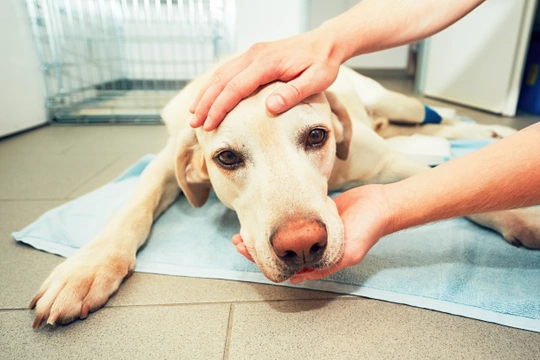
Dog cancer: how to spot and treat it
Dr Lizzie Youens BSc(Hons) BVSc MRCVS
Just like humans, and many other species, dogs can get tumours too. Dog cancer is a common concern for pet owners, very understandably, and all the different types of cancer can be confusing and overwhelming. Understanding more about this disease can be helpful if you are concerned about your pet, or have recently received a diagnosis for your canine friend.
There are many different types of cancer, and this can lead to a huge variety of dog cancer symptoms. It is important to remember that some cancers are more aggressive than others and that there are a range of treatments and supportive therapies that can help if your pooch is diagnosed with a tumour.
What is cancer?
Cancer is when a random cell in your dog begins to replicate uncontrollably. This usually leads to a tumour (a cancer lump on a dog), which can then do damage to the surrounding organs and tissues of your dog’s body. These lumps can be on the outside of the body, such as dog skin cancer or dog nose cancer, or internally, such as dog bone cancer or spleen cancer in dogs.
Not all tumours cause health problems. Benign cancers are slow growing, don’t spread around the body, and usually don’t cause illness (unless their size gets in the way of another body part). On the other hand, malignant tumours are more problematic: they grow rapidly, spread around the body, and tend to cause dogs to become poorly.
Symptoms of cancer in dogs
Different types of tumours can cause differing signs, for example, a dog with testicular cancer may well show different symptoms than a dog with liver cancer.
However, there are some symptoms that many types of cancer can cause:
- A lump or mass: this can be on the skin, or felt internally
- Weight loss
- Reduced appetite
- Lethargy, sleeping more
- Coughing or difficulty breathing
- Ongoing gastrointestinal signs such as vomiting or diarrhoea
If you have a dog with any of these symptoms, don’t panic! None of them are signs a dog is dying of cancer; they are merely signals that all is not right with your dog, and many of these symptoms are common in cancer patients.
Diagnosis and Treatment
If you have any concerns about your dog’s health, it is always best to take them to the vet. Your vet will be able to discuss any concerns and give your pooch a thorough check-over. It is difficult to diagnose cancer without some further tests, so your dog may need a lump sampled, some blood tests done, or some x-rays or ultrasounds taken.
If your pup is given the diagnosis that all pet owners dread, take a breath! Veterinary medicine is advancing all the time, and there are often options for managing and treating these conditions.
Your vet may discuss the following options with you:
- Surgery: masses are often removed surgically, either to fully remove the tumour or to reduce its size. Surgery can also help prevent cancers from spreading, such as with breast cancer in dogs. In some cases, surgery may be completely curative, such as in some cases of testicular cancer in dogs, or they may need other treatments as well.
- Chemotherapy: these are drugs that kill cancer cells, or slow their growth. Vets tend to give chemotherapy drugs at much lower doses than in human medicine, so the side effects are less aggressive. There are many types of chemotherapy. This kind of treatment may be suggested for cancers that easily spread around the body, such as dog stomach cancer, lymphoma, or blood cancers.
However, while considering chemotherapy treatment for your dog, have in mind that chemotherapy residues are excreted in the patient's urine, blood and saliva, so if there are small children, pregnant women or people on immunosuppressants in the household, it is a risk for them. - Radiotherapy: treatment that kills cancer cells using radiation. It is only recommended for certain types of cancers and is available at some specialist sites around the U.K.
Treatment may require a combination of therapies, such as surgery followed by chemotherapy for malignant dog spleen cancer or surgery followed by radiation for large skin tumours that are hard to remove in their entirety.
If your dog’s cancer can’t be treated or has been treated but returned, you may opt for palliative care. This involves using medications such as pain relief to keep your pet happy and comfortable for their last stages of life.
Looking forward
Thankfully, our dogs don’t suffer from the emotional burden of cancer, but it can be very distressing for a pet owner to be given this diagnosis for your pet. If your dog is unwell at all, always take them to the vet. Early detection of problems can have a large impact on treatment options and life expectancy. There are a variety of ways that we can tackle this scary disease, and your vet will be able to support you in making the best decisions for you and your doggy companion.



